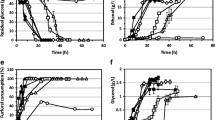Abstract
N-Lauroyl sarcosine (LS), a cationic, non-toxic and biodegradable detergent readily permeabilized whole cells of baker’s yeast (Saccharomyces cerevisiae). Permeabilization was carried out to increase assayable cellular catalase activity, an enzyme of great physiological and industrial importance, and to release 5′-nucleotides which find food/nutritional applications. The event of permeabilization was concentration, time and temperature dependent. Maximum permeabilization of yeast cells were observed when 1 g wet weight (0.2 g dry wt) of cells were permeabilized with 1.0 ml of 2% LS at 45 °C for 15 min. LS-permeabilized cells showed 350-fold increase in catalase activity and the supernatant obtained after permeabilization was rich in 5′-nucleotides. LS-permeabilized baker’s yeast cells can be used as a source of biocatalyst and to isolate valuable by-products.


Similar content being viewed by others
Abbreviations
- LS:
-
N-Lauroyl sarcosine
References
Chelico L, Khachatourians GG (2003) Permeabilization of Beauveria bassiana blastospores for in situ enzymatic assays. Mycologia 95(5):976–981
Felix H (1982) Permeabilized cells. Anal Biochem 120:211–234
Friedrich P (1984) In: Supramolecular enzyme organization. Pergamon Press, New York, pp 210
Gowda LR, Bachhawat N, Bhat SG (1991) Permeabilization of Bakers’ yeast by cetyltrimethylammonium bromide for intracellular enzyme catalysis. Enzyme Microbiol Technol 13:154–157
Shekar S, Nagajyothi B, Bhat SG (1999) Preparation of detergent permeabilized Bakers’ yeast whole cell catalase. Process Biochem 34:349–354
Panesar R, Panesar PS, Singh RS, Kennedy JF, Bera MB (2007) Production of lactose-hydrolyzed milk using ethanol permeabilized yeast cells. Food Chem 101:786–790
Oertel W, Goulian M (1979) Deoxyribonucleic acid synthesis in Saccharomyces cerevisiae permeabilized cells with ether. J Bacteriol 140:333–341
Sorol MR, Pereyra E, Mizyrycki C, Silvia Rossi S, Moreno S (2001) Protein kinase A activity in permeabilized cells as an approximation to in vivo activity. Exp Cell Res 271:337–343
Liu Y, Fujita Y, Kondo A, Fukuda H (2000) Preparation of high activity whole cell biocatalyst by permeabilization of recombinant yeast with alcohol. J Biosci Bioeng 89(6):554–558
Kippert G (1995) A rapid permeabilization method procedure for accurate quantitative determination of β-galactosidase activity in yeast cells. FEMS Microbiol Lett 128:201–206
Seip JE, Cosimo RD (1992) Optimization of accessible catalase activity in polyacrylamide gel immobilized Saccharomyces cerevisiae. Biotechnol Bioeng 40:638–642
Laouar L, Mulligan BJ, Lowe KC (1992) Yeast permeabilization with surfactants. Biotechnol Lett 14:719–720
Sestak S, Farkas V (2001) In situ assays of fungal enzymes in cells permeabilized by osmotic shock. Anal Biochem 292:34–39
Oliveira DE, Lucia AC, Neto S, Panek AD (1981) Permeabilization of yeast for in situ determination of α-glucosidase. Anal Biochem 113:188–192
Chow C, Palecek SP (2004) Enzyme encapsulation in permeabilized Saccharomyces cerevisiae cells. Biotechnol Prog 20:449–456
Görenek G, Akyilmaz E, Dinçkaya E (2004) Immobilization of catalase by entrapping in alginate beads and catalase biosensor preparation for the determination of hydrogen peroxide decomposition. Artif Blood Substit Biotechnol 32(3):453–461
Kubal BS, D’Souza SF (2004) Immobilzation of catalase by entrapment of permeabilized yeast cells in hen egg white using glutaraldehyde. J Biochem Biophys Methods 59(1):61–4
Costa SA, Tzanov T, Paar A, Gudelj M, Gubitz GM, Cavaco-Paulo A (2001) Immobilization of catalase from Bacillus SF on alumina for the treatment of textile bleaching effluents. Enzyme Microb Technol 28(9–10):815–819
Tzanov T, Costa SA, Gübitz GM, Cavaco-Paulo A (2002) Hydrogen peroxide generation with immobilized glucose oxidase for textile bleaching. J Biotechnol 93(1):87–94
Aebi H (1984) Catalase in vitro. Methods Enzymol 105:121–126
Yu M, Wei Y, Zhao L, Jiang L, Zhu X, Qi W (2007) Bioconversion of ethyl 4-chloro–3-oxobutanoate by permeabilized fresh brewer’s yeast cells in the presence of allyl bromide. J Ind Microbiol Biotechnol 34:151–156
Presecki AV, Vasic-Racki D (2005) Production of l-malic acid by permeabilized cells of commercial Saccharomyces sp strains. Biotechnol Lett 27(23–24):1835–1839
Environmental Protection Agency’s Federal Register (1999) vol 64, Number 129, pp 36640–36642
Foster KA, Frackman S, Jol1y JF (1995) In: Rehm H, Reed G, Pihler A, Stadler P (eds) Biotechnology: enzymes biomass Food as Feed, vol 9. VCH Publishers, Weinheim, pp 73
Bhat N, Naina NS, Gowda LR, Bhat SG (1993) Detergent permeabilized yeast cells as the source of intracellular enzymes for estimation of biomolecules. Enzyme Microb Technol 15:796–800
Bachhawat N, Gowda LR, Bhat SG (1996) Single step method of preparation of detergent-permeabilized Kluyveromyces fragilis for lactose hydrolysis. Process Biochem 31:21–25
Upadhya R, Nagajyothi, Bhat SG (1999) d-Amino acid oxidase and catalase of detergent permeabilized Rhodotorula gracilis cells and its potential use for the synthesis of α-keto acids. Process Biochem 35:7–13
Galabova D, Tuleva B, Spasova D (1996) Permeabilization of Yarrowia lipolytica cells by triton X-100. Enz Microbiol Technol 18:18–22
Ahyayauch H, Larijani B, Alonso A, Goñi FM (2006) Detergent solubilization of phosphatidylcholine bilayers in the fluid state: influence of the acyl chain structure. Biochim Biophys Acta 1758(2):190–196
Goñi FM, Alonso A (2000) Spectroscopic techniques in the study of membrane solubilization, reconstitution and permeabilization by detergents. Biochim Biophys Acta 1508(1–2):51–68
Le Maire M, Champeil P, Moller JV (2000) Interaction of membrane proteins and lipids with solubilizing detergents. Biochim Biophys Acta 1508(1–2):86–111
Tribet C, Vial F (2008) Flexible macromolecules attached to lipid bilayers: Impact on fluidity, curvature, permeability and stability of the membranes. Soft Matter 4:68–81
Sanderson JM (2005) Peptide-lipid interactions: insights and perspectives. Org Biomol Chem 3:201–212
Tan Q, Song Q, Wei D (2006) Single-pot conversion of cephalosporin C to 7-aminocephalosporanic acid using cell-bound and support-bound enzymes. Enzyme Microb Technol 39(5):1166–1172
Acknowledgments
The authors would like to thank Dr. Lalitha R Gowda, Scientist, Protein Chemistry and Technology, CFTRI, for useful suggestions and discussions. Jessy Abraham would like to thank DBT for the award of Junior Research Fellowship and CSIR for the award of Senior Research Fellowship.
Author information
Authors and Affiliations
Corresponding author
Rights and permissions
About this article
Cite this article
Abraham, J., Bhat, S.G. Permeabilization of baker’s yeast with N-lauroyl sarcosine. J Ind Microbiol Biotechnol 35, 799–804 (2008). https://doi.org/10.1007/s10295-008-0350-9
Received:
Accepted:
Published:
Issue Date:
DOI: https://doi.org/10.1007/s10295-008-0350-9




